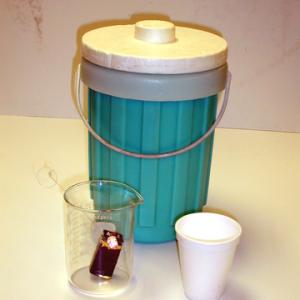College of Liberal Arts & Sciences
4A40.45 - Liquid Nitrogen - Speed of Chemical Reactions
See also 4A40.45 in Chemistry and Physics of Everyday Experience
Snap the LED unit onto the 9 volt battery. Place this into the clear beaker and fill the beaker with liquid nitrogen. As the battery cools the LED will become dimmer and will go out completely when the battery reaches liquid nitrogen temperature. The chemical reaction has now slowed to an extent where it is no longer able to light the LED. Remove the battery and LED unit from the liquid nitrogen and allow them to warm up. As the battery warms the LED will start to glow. The warmer the battery gets the brighter the LED will shine.
- Axel Lorke, "Boiling Eggs, Radiation Damage, and the Arrhenius Plot", Physics Today, Vol. 74, #5, May 2021, p. 66.
- Janice VanCleave, "Speedy", Janice VanCleave's 203 Ice, Freezing, Frosty, Cool & Wild Experiments , p. 57.
Disclaimer: These demonstrations are provided only for illustrative use by persons affiliated with The University of Iowa and only under the direction of a trained instructor or physicist. The University of Iowa is not responsible for demonstrations performed by those using their own equipment or who choose to use this reference material for their own purpose. The demonstrations included here are within the public domain and can be found in materials contained in libraries, bookstores, and through electronic sources. Performing all or any portion of any of these demonstrations, with or without revisions not depicted here entails inherent risks. These risks include, without limitation, bodily injury (and possibly death), including risks to health that may be temporary or permanent and that may exacerbate a pre-existing medical condition; and property loss or damage. Anyone performing any part of these demonstrations, even with revisions, knowingly and voluntarily assumes all risks associated with them.
